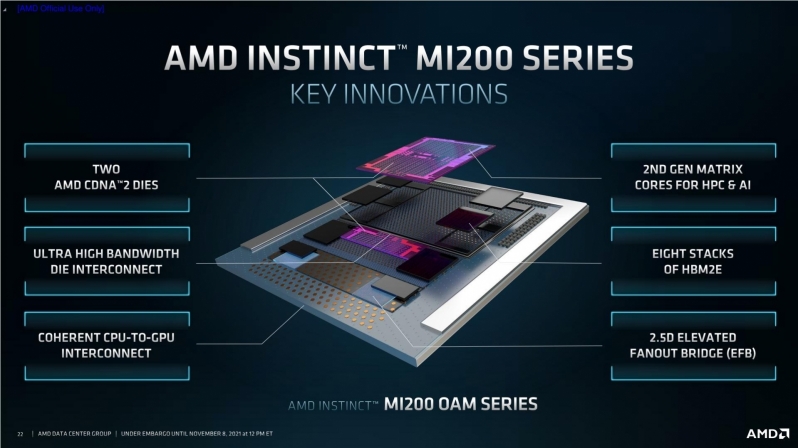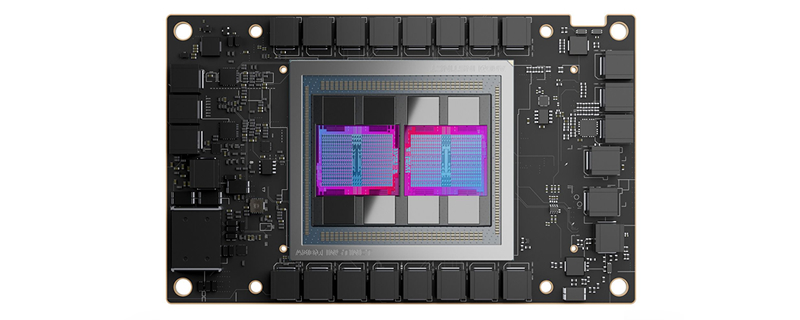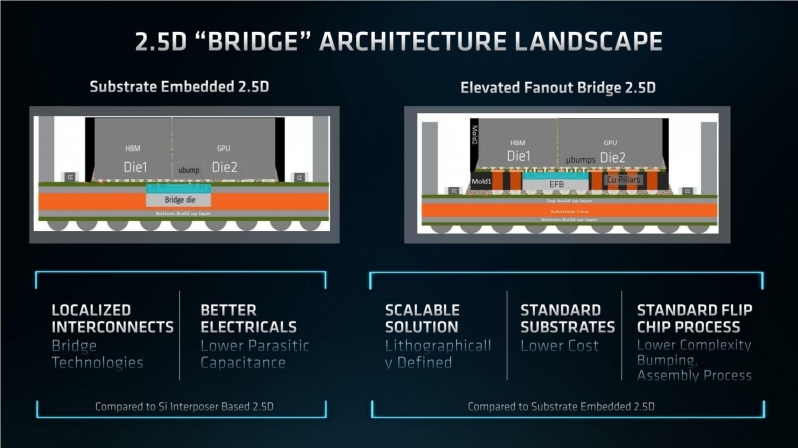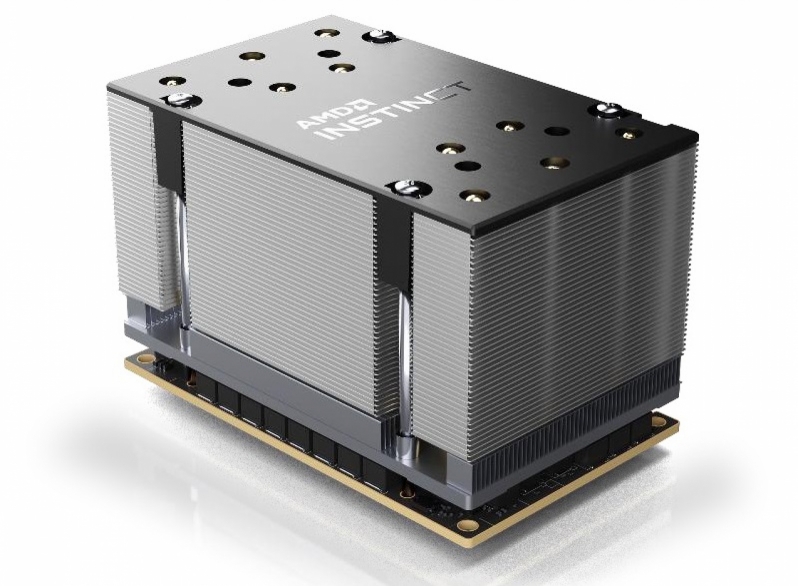AMD’s Instinct MI200 is a Gamechanger for AMD’s HPC Accelerator Efforts
AMD takes the chiplet revolution to the GPU market
AMD has created what they are calling the world’s “first exascale-class GPU accelerators” with their AMD Instinct MI200 series. Alongside their EPYC processors, AMD’s new MI250X accelerators will power the world’s first Exascale supercomputer, the Oak Ridge National Laboratory Horizon supercomputer.Â
The AMD Instinct MI250X is the MI200 series’ flagship, offering users a dual-GPU design, AMD’s 3rd Gen Infinity Architecture, and 128GB of HBM2e memory.Â
With their MI250X, AMD has brought the chiplet revolution to the GPU market, bringing together two GPU dies using their infinity architecture. These two GPU dies are functionally independent, though data can be moved between both chips quickly using AMD’s Infinity Architecture. That said, AMD’s solution will not be as fast as an equivalent monolithic product.Â
AMD’s MI250X uses AMD’s CDNA 2 architecture and is built using TSMC’s 6nm lithography node. In total, AMD’s multi-chip GPU design can deliver up to 47.9 TFLOPS of FP64 compute performance, allowing AMD to deliver leadership performance in many workloads. With their MI250X, AMD’s promising a 4.9X performance increase in HPC performance when compared to competing data center accelerators, though it is worth remembering that AMD is cherry-picking its data to showcase its product in the best light.Â
 Â Â
 Â
With CDNA 2 and their MI200 series products, AMD has showcased that they are capable of delivering a product that sits firmly within the high-end of the accelerator market, setting up the company for a lot of datacenter-driven GPU growth.Â
With their MI200 series products, AMD has also utilised a new 2.5-D bridge architecture to connect their GPU dies to their HBM2e memory modules. This solution should be cheaper and less complex than traditional 2.5D interposers. This innovation will make AMD’s future HBM-based GPUs easier to produce and more affordable, which is great news everyone. Better still, AMD’s 2.5-D bridge technology could be utilised by other future AMD products.Â
What follows is AMD’s Press Release for their Radeon Instinct MI200 series accelerators.Â
 Â Â
 Â
PR –Â New AMD Instinct MI200 Series Accelerators Bring Leadership HPC and AI Performance to Power Exascale Systems and More
AMD (NASDAQ: AMD) today announced the new AMD Instinct™ MI200 series accelerators, the first exascale-class GPU accelerators. AMD Instinct MI200 series accelerators includes the world’s fastest high performance computing (HPC) and artificial intelligence (AI) accelerator,1 the AMD Instinct™ MI250X.
Built on AMD CDNAâ„¢ 2 architecture, AMD Instinct MI200 series accelerators deliver leading application performance for a broad set of HPC workloads.2 The AMD Instinct MI250X accelerator provides up to 4.9X better performance than competitive accelerators for double precision (FP64) HPC applications and surpasses 380 teraflops of peak theoretical half-precision (FP16) for AI workloads to enable disruptive approaches in further accelerating data-driven research.
“AMD Instinct MI200 accelerators deliver leadership HPC and AI performance, helping scientists make generational leaps in research that can dramatically shorten the time between initial hypothesis and discovery,†said Forrest Norrod, senior vice president and general manager, Data Center and Embedded Solutions Business Group, AMD. “With key innovations in architecture, packaging and system design, the AMD Instinct MI200 series accelerators are the most advanced data center GPUs ever, providing exceptional performance for supercomputers and data centers to solve the world’s most complex problems.â€
Exascale With AMD
AMD, in collaboration with the U.S. Department of Energy, Oak Ridge National Laboratory, and HPE, designed the Frontier supercomputer expected to deliver more than 1.5 exaflops of peak computing power. Powered by optimized 3rd Gen AMD EPYCâ„¢ CPUs and AMD Instinct MI250X accelerators, Frontier will push the boundaries of scientific discovery by dramatically enhancing performance of AI, analytics, and simulation at scale, helping scientists to pack in more calculations, identify new patterns in data, and develop innovative data analysis methods to accelerate the pace of scientific discovery.
“The Frontier supercomputer is the culmination of a strong collaboration between AMD, HPE and the U.S. Department of Energy, to provide an exascale-capable system that pushes the boundaries of scientific discovery by dramatically enhancing performance of artificial intelligence, analytics, and simulation at scale,†said Thomas Zacharia, director, Oak Ridge National Laboratory.
Powering The Future of HPC
The AMD Instinct MI200 series accelerators, combined with 3rd Gen AMD EPYC CPUs and the ROCmâ„¢ 5.0 open software platform, are designed to propel new discoveries for the exascale era and tackle our most pressing challenges from climate change to vaccine research.
Key capabilities and features of the AMD Instinct MI200 series accelerators include:
– AMD CDNAâ„¢ 2 architecture – 2nd Gen Matrix Cores accelerating FP64 and FP32 matrix operations, delivering up to 4X the peak theoretical FP64 performance vs. AMD previous gen GPUs. 1,3,4
– Leadership Packaging Technology – Industry-first multi-die GPU design with 2.5D Elevated Fanout Bridge (EFB) technology delivers 1.8X more cores and 2.7X higher memory bandwidth vs. AMD previous gen GPUs, offering the industry’s best aggregate peak theoretical memory bandwidth at 3.2 terabytes per second. 4,5,6
– 3rd Gen AMD Infinity Fabricâ„¢ technology – Up to 8 Infinity Fabric links connect the AMD Instinct MI200 with 3rd Gen EPYC CPUs and other GPUs in the node to enable unified CPU/GPU memory coherency and maximize system throughput, allowing for an easier on-ramp for CPU codes to tap the power of accelerators.
Software for Enabling Exascale Science
AMD ROCmâ„¢ is an open software platform allowing researchers to tap the power of AMD Instinctâ„¢ accelerators to drive scientific discoveries. The ROCm platform is built on the foundation of open portability, supporting environments across multiple accelerator vendors and architectures. With ROCm 5.0, AMD extends its open platform powering top HPC and AI applications with AMD Instinct MI200 series accelerators, increasing accessibility of ROCm for developers and delivering leadership performance across key workloads.
Through the AMD Infinity Hub, researchers, data scientists and end-users can easily find, download and install containerized HPC apps and ML frameworks that are optimized and supported on AMD Instinct accelerators and ROCm. The hub currently offers a range of containers supporting either Radeon Instinctâ„¢ MI50, AMD Instinctâ„¢ MI100 or AMD Instinct MI200 accelerators including several applications like Chroma, CP2k, LAMMPS, NAMD, OpenMM and more, along with popular ML frameworks TensorFlow and PyTorch. New containers are continually being added to the hub.
Available Server Solutions
The AMD Instinct MI250X and AMD Instinct MI250 are available in the open-hardware compute accelerator module or OCP Accelerator Module (OAM) form factor. The AMD Instinct MI210 will be available in a PCIe® card form factor in OEM servers.
The AMD MI250X accelerator is currently available from HPE in the HPE Cray EX Supercomputer, and additional AMD Instinct MI200 series accelerators are expected in systems from major OEM and ODM partners in enterprise markets in Q1 2022, including ASUS, ATOS, Dell Technologies, Gigabyte, Hewlett Packard Enterprise (HPE), Lenovo, Penguin Computing and Supermicro.
You can join the discussion on AMD’s Instinct MI200 accelerator on the OC3D Forums.Â





